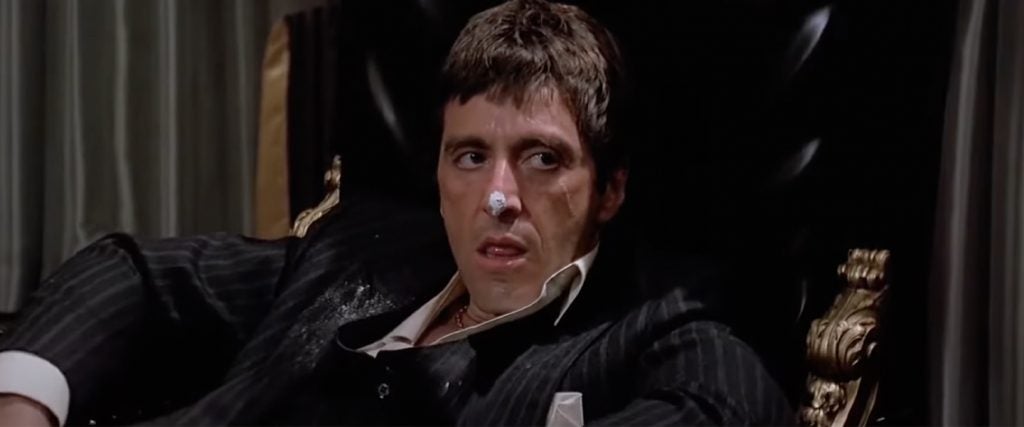Watching people snort coke on TV and in films can be disconcerting. This is particularly true when people like Laura Palmer in Twin Peaks: Fire Walk With Me do two fat lines immediately before bed, or Andy Jones in Boiling Point has a massive heart attack afterwards. Other times it’s unnerving because it’s particularly realistic, like when Arabella and Terry in I May Destroy You get fucked up while partying in Italy. But mostly, it’s worrying because your mind always wanders to the question: WTF are those actors snorting? Which also begs a second question: Is it tasty and should I try it?
Movie drugs — whether tasty or not — can be made out of a variety of different things. Cocaine is often recreated with cornstarch, baby powder, lactose powder or a vitamin powder. Weed seems like it could easily be substituted with tobacco, but as Insider reported, tobacco smoke isn’t as heavy as weed smoke, meaning movie cannabis usually needs to include some kind of herb, or a marijuana strain that doesn’t contain THC. Natalie Kearns, an Ontario-based theater props master, says she usually uses oregano for weed, and a Honeyrose herbal smoking mix when the actor has to actually smoke a joint. “The herbal company uses apple juice to soak the herbs, so it’s more mellow than tobacco,” she explains.
For heroin, prop master Joel Barkow, who made fake drugs for shows like The Sopranos, told Insider that he tends to use a combination of pancake waffle mix and cocoa powder. If it’s being injected, however, the mixture has to melt like real heroin would, so instead he uses brown sugar and water (the actor then “injects” the heroin with a specially engineered retractable needle).
As for pills, Kearns says she typically uses candy or mints, “depending on the type of pill.” “You can buy empty gel capsules from a vitamin store and fill them with any edible substance,” she continues. “There’s also sugar pills, but I’ve never bothered to buy those because candy and mints are realistic enough onstage and easier to get.” She notes that, because the audience is so far away in the theater, you can “get away with a lot more ‘faking it’ than film or TV can.”
Terry Stone, an actor and advocate for the newly launched film and TV digital currency FilmCoin, has shot scenes where he’s had to sniff “coke,” as well as smoke both “cannabis” and “heroin.” He says smoking the fake drugs was the worst of the three “as you inhale a load of fumes and, as a non-smoker, it made me feel sick.” The coke, however, was Stone’s fake drug of choice because it was made out of glucose powder — after snorting a few lines, he got a little energy burst. And although he describes the cocaine as “sweet” and tasting like “a watered-down sugar,” he wouldn’t consider his experience with movie drugs as “tasty.” In fact, herb taste aside, Stone hated smoking on set. “I had to use mouthwash to get rid of the taste,” he tells me, “and your fingers go all green and brown. It wasn’t much fun at all.”
Although it’s mostly safe to do fake drugs, actors’ allergies have to be taken into consideration, too. There have also been a handful of situations where things haven’t gone quite to plan — like when Al Pacino permanently damaged his nasal passage after snorting loads of powdered milk in Scarface, or when Jonah Hill famously inhaled so much Vitamin D while filming The Wolf of Wall Street that he had to be hospitalized with bronchitis. To avoid this, prop masters will sometimes use a suction device that can be hidden in the rolled-up paper money actors snort things with, so they don’t have to ingest anything at all. Or, says Kearns, they can coat the inside of the snorting device (again, like, hundred-dollar bills) to “trap some of the powder so less gets inhaled.”
Well, that makes me feel a little better about Laura Palmer’s bedtime routine. I just hope she got a little “energy burst” out of it, too.

